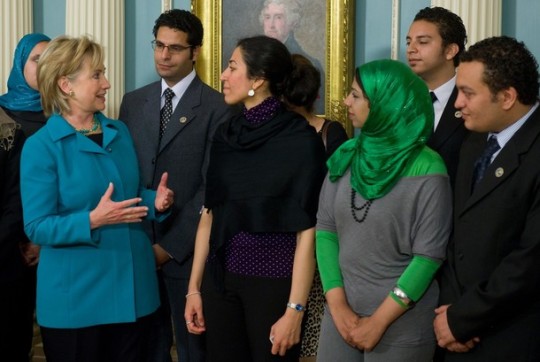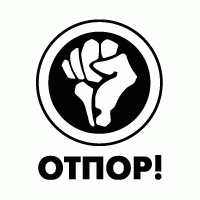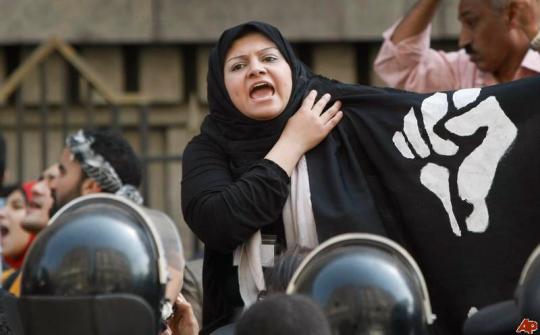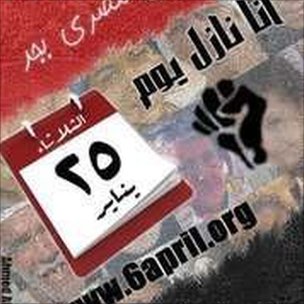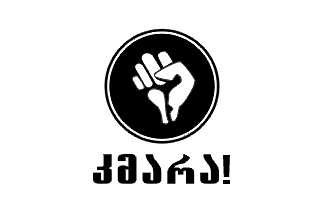Aug 15
20180
Etica y Transparencia National Democratic Institute National Endowment for Democracy OAS SOSNicaraguaUK USAID
The NGOisation of Nicaragua
Ymgyrch Cefnogi Nicaragua Cymru – Wales Nicaragua Solidarity Campaign
August 6, 2018
A woman sweeps the Cuba Plaza backdropped by a mural depicting Cuba’s former President Fidel Castro and Nicaragua’s President Daniel Ortega, in Managua, Nicaragua. (AP Photo/Esteban Felix)
After the initial protests and deaths, the opposition coalesced around the Alianza Civica. Many of the players in this unlikely alliance came from the business sector (previously happy to sit down with the Sandindistas); civil society; and students. Some of the organisations were directly funded by the National Endowment for Democracy. Others had decided the wind was now blowing against the Ortega Presidency, and it was time to jump ship. All were held together by the ‘mediation’ of the Catholic Church. Ironically, the church could be said to have sown the seeds of a lot of the discontent with the Sandinista government when they manoeuvred to get rid of the right to abortion three weeks before the Presidential election in 2006, which the FSLN won after 16 years out of power.
Contradictions in the Nicaraguan opposition
If you want to find out what the opposition hoped for, you can do no worse than read this by Azahálea Solís (who was part of the National Dialogue), written shortly after the National Dialogue talks broke down at the end of May. The reality is this was the high point in the opposition to the Ortega government, with a single demand for him to step down with elections to follow quickly.
This was explicit from the beginning. Miami-born student leader Lesther Aleman received widespread praise from some sections of the Nicaraguan and international press when he told Daniel Ortega in the first Dialogue meeting: “This is not a dialogue table, it is a table to negotiate your departure, and you know it very well because it is the people who have requested it!… Surrender before the entire population!”
By the end of the third meeting at the end of May opposition organisations were actively encouraging a military coup. On June 1 electoral observation organisation Etica y Transparencia called on “the corresponding authorities to ensure the appearance in the courts of these two (Daniel Ortega and Rosario Murillo) thus-far alleged criminals” and on the Army to “ensure implementation of the prompt and necessary arrests, as well as a fair trial.” Etica y Transparenica have long received National Endowment for Democracy funding through the National Democratic Institute. In 2012 one of EyT’s leading lights made the jump in the other direction after 11 years with Etica y Transparencia. Abril Perez became a Reagan-Fascell Fellow at the National Endowment for Democracy, where she still works today.
Seen from two months on, it’s easy to see that if the opposition had not obsessed with removing Ortega here and now via a soft coup, instead of making changes to the electoral system and timetable (which was already being discussed with the Organisation of American States), then they would now be in a strong position. The OAS said that electoral reform proposals would be presented to the government in January 2019.
Instead, the Alianza went down the road of more road blocks, more confrontation, more economic pain. Or what Michael Healy, one of the business leaders in the National Dialogue, stated: “We are willing to pay the price [of continued street conflict] to see Ortega leave.” The reality was, of course, it wasn’t Healy and his fellow members of the Alianza who were paying the price on the streets. Their position is comprehensively taken apart here, describing the contradictions which existed within the Alianza.
Contradictions at home
Those same contradictions exist with those who having been supporting the opposition outside of Nicaragua – Wales and the UK included. At first glance their criticism of the FSLN governments since 2007 comes from the left. Ortega has betrayed Sandinismo, with Nicaragua’s neo-liberal ‘navigation of capitalist waters’ (as one journalist described it to us in February). It is curious then to see SOSNicaraguaUK re-tweeting messages from Florida Republican Congress members, some of the most reactionary in the US. Stranger still to see them re-tweeting Trump Vice President Mike Pence, who’s politics are straight out of The Handmaid’s Tale. The VP for Gilead has called for the removal of a string of governments in Latin America.
Many of the opposition supporters in the UK have had long relationships with Nicaraguan NGOs. Many of the NGOs sprung up after the chaos that engulfed Nicaragua when the revolution ended in 1990. The huge experiment in participatory democracy in 1980s Nicaragua cleaved into two halves – a ‘professional’ NGO sector which attracted foreign funding, and grassroots organisations (‘GROs’, like the co-operatives, unions and the Movimiento Comunal) which were left to themselves. Their fates couldn’t have been more different. From 1990 to 2005 NGO numbers grew from 300 to 2,000, and their funding grew from $90 million in 2000 to $289 million in 2005. GROs fared less well. Trade union membership fell from 22% in 1989 to less than 8% in 2008. The number of co-operatives fell from 3,800 to 400 in 1999 (see here for an excellent analysis of the NGOisation of Nicaragua). The success of the NGOs were due to neo-liberal programmes emphasising the sector over governments, and many of the brigadistas during the 80s moving into positions within aid and funding agencies, and channelling funds to ‘trusted partners’ in Nicaragua.
To a great extent this has been reversed since the FSLN regained power in 2007. Trade unions membership has grown considerably, and the number of co-operatives has passed 4,500. At the same time the funding of NGOs in Nicaragua has been squeezed, as donor countries have either chosen to prioritise other regions, or have refused to support an Ortega-led Nicaragua.
Accountable to whom?
What has all this got to do with the unrest? Many of Nicaragua’s NGOs have thrown in their lot with the opposition. Many of the grassroots organisations – like the ATC, the Co-operative sector, and the Movimiento Comunal – have continued to call for support for the National Dialogue. Unlike the trade unions, these three have no formal link with the FSLN. On many occasions they have challenged the government on their policies. But they still were quick to support the dialogue.
The difference between the NGOs and GROs is striking for a very important reason, one which was highlighted by the research above. The grassroots organisations are constituted from the ground up, accountable to their members, and speak on their behalf. The NGOs have no formal accountability to their beneficiaries (they rarely have members), and are more accountable to their donors than Nicaraguans. As we have noted elsewhere, many of the most vocal organisations in the opposition have received over $4 million from the National Endowment for Democracy over the past four years. Even more striking, USAID pumped $31 million into Nicaragua last year.
What is puzzling is that many of the supporters of SOSNicaraguaUK know this. Many have visited Nicaragua for decades, have long lasting friendships within the NGOs, but have also worked with the grassroots organisations.
So why have they decided to privilege the viewpoint of the NGO sector, whilst ignoring independent organisations in Nicaragua which are democratic and bottom-up, and who call for a National Dialogue as the best way to avoid further bloodshed in the country? Here are some of the views from Nicaragua they don’t share.
Extract from Statement by ATC, May 17 (Association de Trabajadores del Campo has 52,000 members, and is a member of Via Campesina)
Historically, the ATC has been a participant in the Sandinista struggle. In truth, we have not felt consulted or represented by the current FSLN government. The current coup attempt makes use of these historical contradictions and is trying to co-opt the symbols, slogans, poems and songs of Nicaragua’s Sandinista Revolution, since of course the rightwing has none of its own. However we may feel about Daniel Ortega, the ATC would never contribute to making chaos and sowing violence in order to force the collapse of the democratically elected government in order to install a more docile, Washington-friendly neoliberal government. There are clearly real frustrations in sectors of the
population, especially youth, and if these sectors are unable to find popular organizing processes, they will end up being the cannon fodder for a war, which would be the worst possible situation for the Nicaraguan people.
Extract from statement by SOPPEXCCA, July 12 (SOPPEXCCA is a second tier co-operative with 15 co-operatives made up of 650 families. Similar statements have been issued by the co-operative sector body CONACOOP).
‘The UCA SOPPEXCCA, as an entity of organised small producers, promotes a culture of peace, harmony, respect for the law and democratic participation.
We therefore give our support to peaceful solutions and call for an end to the culture of violence generated in our country owing to the events that we are experiencing and which affect us both individually and collectively, since the peace that we enjoyed in our Nicaragua disappeared in the most abrupt and tempestuous fashion.
We feel the grief of many Nicaraguan families who have lost loved ones, tranquillity and have to face up to the consequences.
We, as Nicaraguans, will also face consequences as it is evident that there will be an economic slowdown that will affect the majority of our people, especially the poorest families, the majority.
Sadly, many dreams are being left behind as we wait for the shining light of peace to emerge again; reconciliation and work will be our standard bearers as we endeavour to lift our country out of the poverty levels we find ourselves in.





















